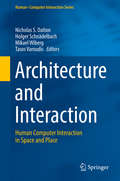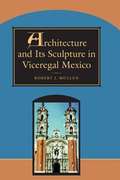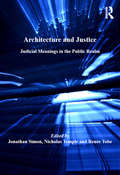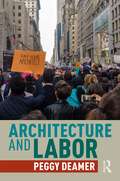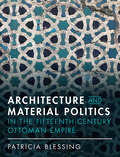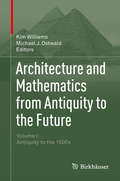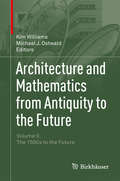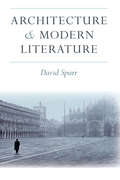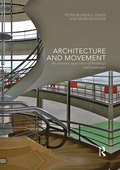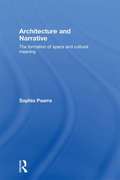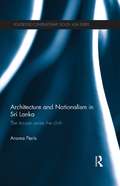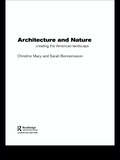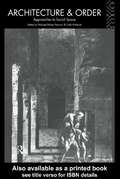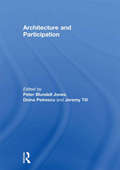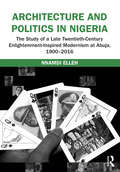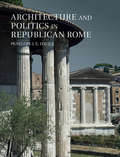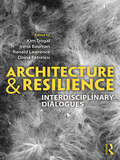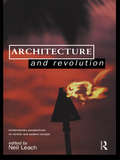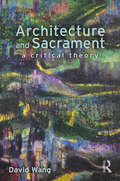- Table View
- List View
Architecture and Health: Guiding Principles for Practice
by Jacob J. Wilhelm Dina BattistoArchitecture and Health recognizes the built environment and health as inextricable encouraging a new mind-set for the profession. Over 40 international award-winning projects are included to explore innovative design principles linked to health outcomes. The book is organized into three interdependent health domains—individual, community, and global—in which each case study proposes context-specific architectural responses. Case studies include children’s hospitals, rehabilitation facilities, elderly housing, mental health facilities, cancer support centers, clinics, healthy communities, healthcare campuses, wellness centers, healing gardens, commercial offices, infrastructure for developing countries, sustainable design, and more. Representing the United States, Africa, Asia, Europe, and Australia, each author brings a new perspective to health and its related architectural response. This book brings a timely focus to a subject matter commonly constricted by normative building practices and transforms the dialogue into one of creativity and innovation. With over 200 color images, this book is an essential read for architects, designers, and students to explore and analyze designed environments that promote health and well-being.
Architecture and Interaction: Human Computer Interaction in Space and Place (Human–Computer Interaction Series #0)
by Mikael Wiberg Nicholas S. Dalton Holger Schnädelbach Tasos VaroudisUbiquitouscomputing has a vision of information and interaction being embedded in theworld around us; this forms the basis of this book. Built environments aresubjects of design and architects have seen digital elements incorporated intothe fabric of buildings as a way of creating environments that meet the dynamicchallenges of future habitation. Methods forprototyping interactive buildings are discussed and the theoretical overlapsbetween both domains are explored. Topics like the role of space and technologywithin the workplace as well as the role of embodiment in understanding howbuildings and technology can influence action are discussed, as well as investigating the creation of place with new methodologies toinvestigate the occupation of buildings and how they can be used to understandspatial technologies. Architectureand Interaction is aimed at researchers and practitioners in the field of computing who want togain a greater insight into the challenges of creating technologies in thebuilt environment and those from the architectural and urban design disciplineswho wish to incorporate digital information technologies in future buildings.
Architecture and Its Sculpture in Viceregal Mexico
by Robert J. MullenThis book grew out of the author's twenty-five-year exploration of Mexico's architectural and sculptural heritage. Combining an enthusiast's love for the subject with a scholar's care for accuracy, it is the perfect introduction to the full range of Mexico's colonial architecture.
Architecture and Justice: Judicial Meanings in the Public Realm (Ashgate Studies In Architecture Ser.)
by Jonathan SimonBringing together leading scholars in the fields of criminology, international law, philosophy and architectural history and theory, this book examines the interrelationships between architecture and justice, highlighting the provocative and curiously ambiguous juncture between the two. Illustrated by a range of disparate and diverse case studies, it draws out the formal language of justice, and extends the effects that architecture has on both the place of, and the individuals subject to, justice. With its multi-disciplinary perspective, the study serves as a platform on which to debate the relationships between the ceremonial, legalistic, administrative and penal aspects of justice, and the spaces that constitute their settings. The structure of the book develops from the particular to the universal, from local situations to the larger city, and thereby examines the role that architecture and urban space play in the deliberations of justice. At the same time, contributors to the volume remind us of the potential impact the built environment can have in undermining the proper juridical processes of a socio-political system. Hence, the book provides both wise counsel and warnings of the role of public/civic space in affirming our sense of a just or unjust society.
Architecture and Labor: The Economy Of Architecture In Theory And Practice
by Peggy DeamerThrough a collection of 13 chapters, Peggy Deamer examines the profession of architecture not as an abstraction, but as an assemblage of architectural workers. What forces prevent architects from empowering ourselves to be more relevant and better rewarded? How can these forces be set aside by new narratives, new organizations and new methods of production? How can we sit at the decision-making table to combat short-term real estate interests for longer-term social and ethical value? How can we pull architecture—its conceptualization, its pedagogy, and its enactment—into the 21st century without succumbing to its neoliberal paradigm? In addressing these controversial questions, Architecture and Labor brings contemporary discourses on creative labor to architecture, a discipline devoid of labor consciousness. This book addresses how, not just what, architects produce and focuses not on the past but on the present. It is sympathetic to the particularly intimate way that architects approach their design work while contextualizing that work historically, institutionally, economically, and ideologically. Architecture and Labor is sure to be a compelling read for pre-professional students, academics, and practitioners.
Architecture and Leadership: The Nature and Role of Space and Place in Organizational Culture (Leadership Horizons)
by Mark A. Roberson Alicia D. CrumptonFrom cathedrals to cubicles, people go to great lengths and expense to design their living and working environments. They want their spaces to be places where they enjoy being, reflecting who they are and what they care about. The resultant environments in turn become loud, albeit unvocal, leaders for people occupying those corresponding spaces. The design and use of work and living spaces typifies and thematizes expectations for the group. Essentially, the architecture of rooms, buildings and cities creates cultures by conveying explicit and implicit messages. This is evident when people approach and walk into St. Basil’s Cathedral in Moscow, the Forbidden City in Beijing, the Sydney Opera House in Sydney, Australia, the Jewish Museum in Berlin, or the Rothko Chapel in Houston, to name some examples. While leaders oftentimes lack the resources to have their spaces mirror the greatest architectural achievements of the world, they are in a position to use the art and science of architecture, at whatever scale is available, to their advantage. The creative and intentional use of space and place advances and promotes cherished values and enhances organizational effectiveness. This book explores the essence of good architecture and establishes relevant connections for leaders and managers to strategically design and use the organizational workplace and space to support their mission and purpose, and create aesthetically meaningful work environments. It equips leaders to be culturally astute on what defines good architecture and to incorporate principles of beauty in their leadership practices accordingly and will be of interest to researchers, academics, professionals, and students in the fields of leadership, organizational studies, and architecture theory and practice.
Architecture and Material Politics in the Fifteenth-century Ottoman Empire
by Patricia BlessingIn this book, Patricia Blessing explores the emergence of Ottoman architecture in the fifteenth century and its connection with broader geographical contexts. Analyzing how transregional exchange shaped building practices, she examines how workers from Anatolia, the Mediterranean, the Balkans, and Iran and Central Asia participated in key construction projects. She also demonstrates how drawn, scalable models on paper served as templates for architectural decorations and supplemented collaborations that involved the mobility of workers. Blessing reveals how the creation of centralized workshops led to the emergence of a clearly defined imperial Ottoman style by 1500, when the flexibility and experimentation of the preceding century was levelled. Her book radically transforms our understanding of Ottoman architecture by exposing the diverse and fluid nature of its formative period. It also provides the reader with an understanding of design, planning, and construction processes of a major empire of the Islamic world.
Architecture and Mathematics from Antiquity to the Future: Volume I: Antiquity to the 1500s
by Michael J. OstwaldEvery age and every culture has relied on the incorporation of mathematics in their works of architecture to imbue the built environment with meaning and order. Mathematics is also central to the production of architecture, to its methods of measurement, fabrication and analysis. This two-volume edited collection presents a detailed portrait of the ways in which two seemingly different disciplines are interconnected. Over almost 100 chapters it illustrates and examines the relationship between architecture and mathematics. Contributors of these chapters come from a wide range of disciplines and backgrounds: architects, mathematicians, historians, theoreticians, scientists and educators. Through this work, architecture may be seen and understood in a new light, by professionals as well as non-professionals. Volume II covers architecture from the Late Renaissance era, through Baroque, Ottoman, Enlightenment, Modern and contemporary styles and approaches. Key figures covered in this volume include Palladio, Michelangelo, Borromini, Sinan, Wren, Wright, Le Corbusier, Breuer, Niemeyer and Kahn. Mathematical themes which are considered include linear algebra, tiling and fractals and the geographic span of the volume's content includes works in the United States of America and Australia, in addition to those in Europe and Asia.
Architecture and Mathematics from Antiquity to the Future: Volume II: The 1500s to the Future
by Kim Williams Michael J. OstwaldEvery age and every culture has relied on the incorporation of mathematics in their works of architecture to imbue the built environment with meaning and order. Mathematics is also central to the production of architecture, to its methods of measurement, fabrication and analysis. This two-volume edited collection presents a detailed portrait of the ways in which two seemingly different disciplines are interconnected. Over almost 100 chapters it illustrates and examines the relationship between architecture and mathematics. Contributors of these chapters come from a wide range of disciplines and backgrounds: architects, mathematicians, historians, theoreticians, scientists and educators. Through this work, architecture may be seen and understood in a new light, by professionals as well as non-professionals. Volume II covers architecture from the Late Renaissance era, through Baroque, Ottoman, Enlightenment, Modern and contemporary styles and approaches. Key figures covered in this volume include Palladio, Michelangelo, Borromini, Sinan, Wren, Wright, Le Corbusier, Breuer, Niemeyer and Kahn. Mathematical themes which are considered include linear algebra, tiling and fractals and the geographic span of the volume's content includes works in the United States of America and Australia, in addition to those in Europe and Asia.
Architecture and Mathematics in Ancient Egypt
by Corinna RossiIn this fascinating study, architect and Egyptologist Corinna Rossi analyses the relationship between mathematics and architecture in ancient Egypt by exploring the use of numbers and geometrical figures in ancient architectural projects and buildings. While previous architectural studies have searched for abstract â ~universal rules' to explain the history of Egyptian architecture, Rossi attempts to reconcile the different approaches of archaeologists, architects and historians of mathematics into a single coherent picture. Using a study of a specific group of monuments, the pyramids, and placing them in the context of their cultural and historical background, Rossi argues that theory and practice of construction must be considered as a continuum, not as two separated fields, in order to allow the original planning process of a building to re-emerge. Highly illustrated with plans, diagrams and figures, this book is essential reading for all scholars of Ancient Egypt and the architecture of ancient cultures.
Architecture and Modern Literature
by David SpurrArchitecture and Modern Literature explores the representation and interpretation of architectural space in modern literature from the early nineteenth century to the present, with the aim of showing how literary production and architectural construction are related as cultural forms in the historical context of modernity. In addressing this subject, it also examines the larger questions of the relation between literature and architecture and the extent to which these two arts define one another in the social and philosophical contexts of modernity. Architecture and Modern Literature will serve as a foundational introduction to the emerging interdisciplinary study of architecture and literature. David Spurr addresses a broad range of material, including literary, critical, and philosophical works in English, French, and German, and proposes a new historical and theoretical overview of this area, in which modern forms of "meaning" in architecture and literature are related to the discourses of being, dwelling, and homelessness.
Architecture and Movement: the Dynamic Experience of Buildings and Landscapes
by Peter Blundell Jones and Mark MeagherThe experience of movement, of moving through buildings, cities, landscapes and in everyday life, is the only involvement most individuals have with the built environment on a daily basis. User experience is so often neglected in architectural study and practice. Architecture and Movement tackles this complex subject for the first time, providing the wide range of perspectives needed to tackle this multi-disciplinary topic. Organised in four parts it: documents the architect’s, planner’s, or designer’s approach, looking at how they have sought to deploy buildings as a promenade and how they have thought or written about it. concentrates on the individual’s experience, and particularly on the primacy of walking, which engages other senses besides the visual. engages with society and social rituals, and how mutually we define the spaces through which we move, both by laying out routes and boundaries and by celebrating thresholds. analyses how we deal with promenades which are not experienced directly but via other mediums such as computer models, drawings, film and television. The wide selection of contributors include academics and practitioners and discuss cases from across the US, UK, Europe and Asia. By mingling such disparate voices in a carefully curated selection of chapters, the book enlarges the understanding of architects, architectural students, designers and planners, alerting them to the many and complex issues involved in the experience of movement.
Architecture and Narrative: The Formation of Space and Cultural Meaning
by Sophia PsarraArchitecture is often seen as the art of a thinking mind that arranges, organizes and establishes relationships between the parts and the whole. It is also seen as the art of designing spaces, which we experience through movement and use. Conceptual ordering, spatial and social narrative are fundamental to the ways in which buildings are shaped, used and perceived. Examining and exploring the ways in which these three dimensions interact in the design and life of buildings, this intriguing book will be of use to anyone with an interest in the theory of architecture and architecture's relationship to the cultural human environment.
Architecture and Nationalism in Sri Lanka: The Trouser Under the Cloth (Routledge Contemporary South Asia Series)
by Anoma PierisThe role of the home, the domestic sphere and the intimate, ethno-cultural identities that are cultivated within it, are critical to understanding the polemical constructions of country and city; tradition and modernity; and regionalism and cosmopolitanism. The home is fundamental to ideas of the homeland that give nationalism its imaginative form and its political trajectory. This book explores positions that are vital to ideas of national belonging through the history of colonial, bourgeois self-fashioning and post colonial identity construction in Sri Lanka. The country remains central to related architectural discourses due to its emergence as a critical site for regional architecture, post-independence. Suggesting patterns of indigenous accommodation and resistance that are expressed through built form, the book argues that the nation grows as an extension of an indigenous private sphere, ostensibly uncontaminated by colonial influences, domesticating institutions and appropriating rural geographies in the pursuit of its hegemonic ideals. This ambitious, comprehensive, wide-ranging book presents an abundance of new and original material and many imaginative insights into the history of architecture and nationalism from the mid nineteenth century to the present day.
Architecture and Nature: Creating the American Landscape
by Sarah Bonnemaison Christine MacyWinner of the 2006 Alice Davis Hitchcock Award! The word 'nature' comes from natura, Latin for birth - as do the words nation, native and innate. But nature and nation share more than a common root, they share a common history where one term has been used to define the other. In the United States, the relationship between nation and nature has been central to its colonial and post-colonial history, from the idea of the noble savage to the myth of the frontier. Narrated, painted and filmed, American landscapes have been central to the construction of a national identity. Architecture and Nature presents an in-depth study of how changing ideas of what nature is and what it means for the country have been represented in buildings and landscapes over the past century.
Architecture and Objects (Art After Nature)
by Graham HarmanThinking through object-oriented ontology—and the work of architects such as Rem Koolhaas and Zaha Hadid—to explore new concepts of the relationship between form and function Object-oriented ontology has become increasingly popular among architectural theorists and practitioners in recent years. Architecture and Objects, the first book on architecture by the founder of object-oriented ontology (OOO), deepens the exchange between architecture and philosophy, providing a new roadmap to OOO&’s influence on the language and practice of contemporary architecture and offering new conceptions of the relationship between form and function. Graham Harman opens with a critique of Heidegger, Derrida, and Deleuze, the three philosophers whose ideas have left the deepest imprint on the field, highlighting the limits of their thinking for architecture. Instead, Harman contends, architecture can employ OOO to reconsider traditional notions of form and function that emphasize their relational characteristics—form with a building&’s visual style, function with its stated purpose—and constrain architecture&’s possibilities through literalism. Harman challenges these understandings by proposing de-relationalized versions of both (zero-form and zero-function) that together provide a convincing rejoinder to Immanuel Kant&’s dismissal of architecture as &“impure.&”Through critical engagement with the writings of Peter Eisenman and fresh assessments of buildings by Rem Koolhaas, Frank Gehry, and Zaha Hadid, Architecture and Objects forwards a bold vision of architecture. Overcoming the difficult task of &“zeroing&” function, Harman concludes, would place architecture at the forefront of a necessary revitalization of exhausted aesthetic paradigms.
Architecture and Order: Approaches to Social Space (Material Cultures)
by Colin Richards Michael Parker PearsonArchitecture is a powerful medium for representing, ordering and classifying the world, and understanding the use of space is fundamental to archaeological inquiry. Architecture and Order draws on the work of archaeologists, social theorists and architects to explore the way in which people relate to the architecture which surrounds them. In many societies, houses and tombs have encoded cultural meanings and values which are invoked and recalled through the practices of daily life.Chapters include explorations of the early farming r archi*eye of Europe, from before the use of metals, to the Classical and Medieval worlds of the Mediterranean and Europe. Research of the recent past and present include an overview of hunter-gatherers' camp organization, a reassessment of the use of space amongst the Dogon of West Africa and an examination of mental disorders relating to the use of space in Britain. The volume goes beyond the implication that culture determines form to develop an approach that integrates meaning and practice.
Architecture and Participation
by Doina Petrescu Peter Blundell Jones Jeremy TillBringing together leading international practitioners and theorists in the field, ranging from the 1960s pioneers of participation to some of the major contemporary figures in the field, Architecture and Participation opens up the social and political aspects of our built environment, and the way that the eventual users may shape it. Divided into three sections, looking at the politics, histories and practices of participation, the book gives both a broad theoretical background and more direct examples of participation in practice. Respectively the book explores participation's broader context, outlining key themes and including work from some seminal European figures and shows examples of how leading practitioners have put their ideas into action. Illustrated throughout, the authors present to students, practitioners and policy makers an exploration of how a participative approach may lead to new spatial conditions, as well as to new types of architectural practices, and investigates the way that the user has been included in the design process.
Architecture and Politics in Nigeria: The Study of a Late Twentieth-Century Enlightenment-Inspired Modernism at Abuja, 1900–2016
by Nnamdi EllehIn 1975, the Nigerian authorities decided to construct a new postcolonial capital called Abuja, and together with several internationally renowned architects these military leaders collaborated to build a city for three million inhabitants. Founded five years after the Civil War with Biafra, which caused around 1.7 million deaths, the city was envisaged as a place where justice would reign and where people from different social, religious, ethnic, and political backgrounds would come together in a peaceful manner and work together to develop their country and its economy. These were all laudable goals, but they ironically mobilized certain forces from around the country in opposition against the Federal Government of Nigeria. The international and modernist style architecture and the fact that the government spent tens of billions of dollars constructing this idealized capital ended up causing more strife and conflict. For groups like Boko Haram, a Nigerian Al-Qaida affiliate organization, and other smaller ethnic groups seeking to have a say in how the country’s oil wealth is spent, Abuja symbolized everything in Nigeria they sought to change. By examining the creation of the modernist national public spaces of Abuja within a broader historical and global context, this book looks at how the successes and the failures of these spaces have affected the citizens of the country and have, in fact, radicalized individuals with these spaces being scene of some of the most important political events and terrorist targets, including bombings and protest rallies. Although focusing on Nigeria’s capital, the study has a wider global implication in that it draws attention to how postcolonial countries that were formed at the turn of the twentieth century are continuously fragmenting and remade by the emergence of new nation states like South Sudan.
Architecture and Politics in Republican Rome
by Davies Penelope J. E.Architecture and Politics in Republican Rome is the first book to explore the intersection between Roman Republican building practices and politics (c. 509-44 BCE). At the start of the period, architectural commissions were carefully controlled by the political system; by the end, buildings were so widely exploited and so rhetorically powerful that Cassius Dio cited abuse of visual culture among the reasons that propelled Julius Caesar's colleagues to murder him in order to safeguard the Republic. In an engaging and wide-ranging text, Penelope J. E. Davies traces the journey between these two points, as politicians developed strategies to manoeuver within the system's constraints. She also explores the urban development and image of Rome, setting out formal aspects of different types of architecture and technological advances such as the mastery of concrete. Elucidating a rich corpus of buildings that have been poorly understand, Davies demonstrates that Republican architecture was much more than a formal precursor to that of imperial Rome.
Architecture and Principles of Systems Engineering (Complex and Enterprise Systems Engineering)
by Charles Dickerson Dimitri N. MavrisThe rapid evolution of technical capabilities in the systems engineering (SE) community requires constant clarification of how to answer the following questions: What is Systems Architecture? How does it relate to Systems Engineering? What is the role of a Systems Architect? How should Systems Architecture be practiced?A perpetual reassessment of concepts and practices is taking place across various systems disciplines at every level in the SE community. Architecture and Principles of Systems Engineering addresses these integral issues and prepares you for changes that will be occurring for years to come. With their simplified discussion of SE, the authors avoid an overly broad analysis of concepts and terminology. Applying their substantial experience in the academic, government, and commercial R&D sectors, this book is organized into detailed sections on: Foundations of Architecture and Systems Engineering Modeling Languages, Frameworks, and Graphical Tools Using Architecture Models in Systems Analysis and Design Aerospace and Defense Systems Engineering Describing ways to improve methods of reasoning and thinking about architecture and systems, the text integrates concepts, standards, and terminologies that embody emerging model-based approaches but remain rooted in the long-standing practices of engineering, science, and mathematics. With an emphasis on maintaining conceptual integrity in system design, this text describes succinct practical approaches that can be applied to the vast array of issues that readers must resolve on a regular basis. An exploration of the important questions above, this book presents the authors’ invaluable experience and insights regarding the path to the future, based on what they have seen work through the power of model-based approaches to architecture and systems engineering.
Architecture and Resilience: Interdisciplinary Dialogues
by Doina Petrescu Kim Trogal Irena Bauman Ranald LawrenceResilience will be a defining quality of the twenty-first century. As we witness the increasingly turbulent effects of climate change, the multiple challenges of resource depletion and wage stagnation, we know that our current ways of living are not resilient. Our urban infrastructures, our buildings, our economies, our ways of managing and governing are still too tightly bound to models of unrestrained free-market growth, individualism and consumerism. Research has shown that the crises arising from climate change will become increasingly frequent and increasingly severe. It is also known that the effects of climate change are not evenly distributed across places and people, and neither are the resources needed to meet these challenges. We will need specific responses in place that engage with, and emerge from, citizens ourselves. This volume takes resilience as a transformative concept to ask where and what architecture might contribute. Bringing together cross-disciplinary perspectives from architecture, urban design, art, geography, building science and psychoanalysis, it aims to open up multiple perspectives of research, spatial strategies and projects that are testing how we can build local resilience in preparation for major societal challenges, defining the position of architecture in urban resilience discourse.
Architecture and Revolution: Contemporary Perspectives on Central and Eastern Europe
by Neil LeachArchitecture and Revolution explores the consequences of the 1989 revolutions in Central and Eastern Europe from an architectural perspective. It presents new writings from a team of renowned architects, philosophers and cultural theorists from both the East and the West. They explore the questions over the built environment that now face architects, planners and politicians in the region. They examine the problems of buildings inherited from the communist era: some are environmentally inadequate, many were designed to serve a now redundant social programme and others carry the stigma of association with previous regimes. Contributors include: Daniel Libeskind, Bernard Tschumi, Laura Mulvey, Helene Cixous, Andrew Benjamin and Frederic Jameson.
Architecture and Ritual in the Churches of Constantinople
by Vasileios MarinisThis book examines the interchange of architecture and ritual in the Middle and Late Byzantine churches of Constantinople (ninth to fifteenth centuries). It employs archaeological and archival data, hagiographic and historical sources, liturgical texts and commentaries, and monastic typika and testaments to integrate the architecture of the medieval churches of Constantinople with liturgical and extra-liturgical practices and their continuously evolving social and cultural context. The book argues against the approach that has dominated Byzantine studies: that of functional determinism, the view that architectural form always follows liturgical function. Instead, proceeding chapter by chapter through the spaces of the Byzantine church, it investigates how architecture responded to the exigencies of the rituals, and how church spaces eventually acquired new uses. The church building is described in the context of the culture and people whose needs it was continually adapted to serve. Rather than viewing churches as frozen in time (usually the time when the last brick was laid), this study argues that they were social constructs and so were never finished, but continually evolving.
Architecture and Sacrament: A Critical Theory
by David WangDavid Wang’s Architecture and Sacrament considers architectural theory from a Christian theological perspective, specifically, the analogy of being (analogia entis). The book tracks social and cultural reasons why the theological literature tends to be separate from contemporary architecture theory. Wang argues that retrieval of the sacramental outlook embedded within the analogy of being, which informed centuries of art and architecture in the West, can shed light on current architectural issues such as "big box stores," the environmental crisis and the loss of sense of community. The book critiques the materialist basis of current architectural discourse, subsumed largely under the banner of critical theory. This volume on how European ideas inform architectural theory complements Wang’s previous book, A Philosophy of Chinese Architecture: Past, Present, Future, and will appeal to architecture students and academics, as well as those grappling with the philosophical moorings of all built environments.

